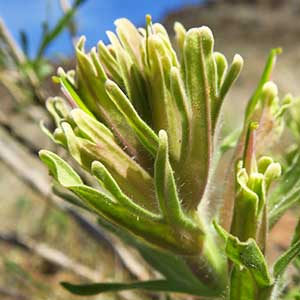Castilleja xanthotricha
Castilleja ornata
John Day or yellow-hairy paintbrush, John Day paintbrush, yellow hair paintbrush, yellow-hair Indian paintbrush
glowing Indian paintbrush, ornate paintbrush
few to several, ± decumbent to erect or ascending, unbranched, sometimes with short, leafy axillary shoots, hairs erect to spreading, long, soft, eglandular, mixed with short stipitate-glandular ones.
solitary or few to several, erect or ascending, often branched low on stem, unbranched distally, hairs appressed or retrorse, medium length, soft, eglandular, mixed with shorter stipitate-glandular ones.
green, linear, lanceolate to broadly lanceolate, oblong, or cuneate, 0.8–5 cm, not fleshy, margins plane to wavy, involute, 0–5-lobed, apex acute, sometimes rounded;
lobes spreading, linear, arising below mid length, nearly as broad as center lobe, apex acute.
green or purple-tinged, proximal forming a rosette, linear-lanceolate to oblong or oblanceolate, 2–4 cm, not fleshy, clasping, margins wavy, sometimes plane, involute, 0-lobed, apex acuminate, acute, or obtuse.
3–14 × 1.5–4.5 cm;
bracts proximally greenish, rarely dull reddish purple, distally white to cream, rarely pale yellow or dull, pale pink (sharply differentiated from proximal coloration), lanceolate or oblong to narrowly ovate, (3–)5–7-lobed;
lobes ascending, linear to obovate, ± broadened distally, medium, long, proximal lobes arising below mid length, central lobe apex broadly rounded to truncate, others acute to rounded.
3–24 × 1.5–3 cm;
bracts proximally green, distally white, sometimes very pale yellow, often aging dull pink or dull red-purple, spatulate, 0-lobed, sometimes seeming lobed due to wavy margins, apex obtuse to rounded.
curved, 17–23 mm;
tube 15–19 mm;
beak exserted, adaxially green, 5–8(–9) mm, puberulent, stipitate-glandular;
abaxial lip deep purple (color sometimes visible through calyx), green, pinkish, or pale yellow, ± prominent, slightly inflated, usually hidden in calyx, sometimes right at top of calyx, 2 mm, ca. 50% as long as beak;
teeth ascending, whitish, yellowish, pink, or green, 1–1.5 mm.
slightly curved, 22–24 mm;
tube 10–13 mm;
beak exserted, adaxially green, 5–10 mm;
abaxial lip pale greenish, reduced, pouches 3, 0.5–1.5 mm, 5–10% as long as beak;
teeth slightly incurved, reduced, pale greenish to white, 0.3–0.7 mm.
colored as bracts, 15–26 mm;
abaxial and adaxial clefts 3.5–7 mm, 25–50% of calyx length, deeper than laterals, lateral 2–5 mm, 12–25% of calyx length;
lobes linear, oblong, or narrowly triangular, center lobe apex usually rounded, lobes acute to rounded.
green throughout or distal margin white aging pink, 15–17 mm;
abaxial and adaxial clefts 6–14 mm, 35–45% of calyx length, deeper than laterals, lateral 0(–0.7) mm, 0(–5)% of calyx length;
lobes short-triangular, abaxial segments longer than adaxials, apex acute to obtuse or rounded.
= 48.
= 24.
Castilleja xanthotricha
Castilleja ornata
Castilleja xanthotricha is endemic to moderate elevations in the sagebrush hills of the John Day River drainage in north-central Oregon. N. H. Holmgren (1971) hypothesized that this tetraploid species is of allopolyploid hybrid origin between C. glandulifera and C. oresbia.
(Discussion copyrighted by Flora of North America; reprinted with permission.)
Castilleja ornata is known from Chihuahua and northern Durango, Mexico, but much of its seasonally moist grassland habitat is now altered by grazing or agriculture, and there are no recent sightings of the species south of the United States border. There is a recently discovered population in southwestern New Mexico, in the southern Animas Valley of Hidalgo County. While very rare, C. ornata lacks federal protection. The small Animas Valley population is the last known extant occurrence, and this population was reduced to two individuals in a census conducted in 2017 (D. Roth, pers. comm.). The species appears to be critically endangered globally and in need of conservation management.
The inflorescences of Castilleja ornata have pale greenish bracts with white apices when young, but the apices often become pale pink to dull reddish with age. Its pubescence, wavy-margined leaves, and unusual bract color also distinguish C. ornata. Castilleja exserta and C. minor are the only other annual paintbrushes in New Mexico and differ from C. ornata by the color of their floral bract apices, which are usually pink to red-purple in C. exserta and bright red in C. minor.
(Discussion copyrighted by Flora of North America; reprinted with permission.)
